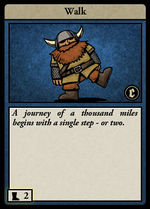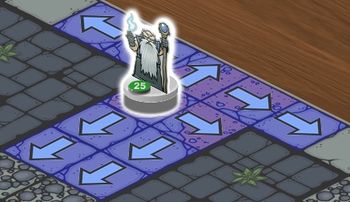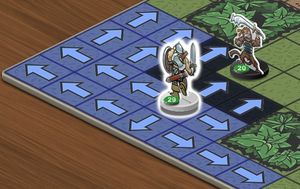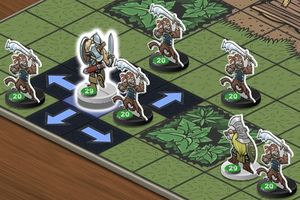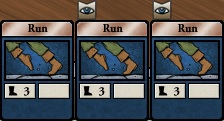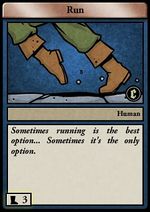Movement
| Line 24: | Line 24: | ||
{| | {| | ||
| − | | STYLE="vertical-align: center; text-align:justify;" align="left" | But move cards aren’t gone from the deck building part of the game either. It’s still highly advantageous to have more movement than the default – if you are the kind of character who can take advantage of it. Rogues and tricky warriors will often want to have more move cards to get into good tactical positions. Even wizards might want some extra moves to get away from melee attackers. Movement is absolute key to this game. It’s easy to start loading up on big attacks and spells, but all those are meaningless if your opponent can maneuver to make them unplayable or ineffective. You get extra move cards from items you equip on your characters. Such item based move cards are not visible until played. Figure 5 shows three [[Cards/Run|run]] cards in hand, two of which are default move cards. The first [[Cards/Run|run]] is from an item and is not visible to your opponent. Such cards are different from the default moves and therefore play a huge strategic role in the game. <br /><br /> Your default move card is determined by your character's race. The dwarf’s default move card is the clunky [[Cards/Walk|Walk]] card, humans get the average [[Cards/Run|Run]] and elves get the extremely useful [[Cards/Dash|Dash]] card. Default move cards will show the race of the character in the [[Cards#Information Bar|information bar]]. | + | | STYLE="vertical-align: center; text-align:justify;" align="left" | But move cards aren’t gone from the deck building part of the game either. It’s still highly advantageous to have more movement than the default – if you are the kind of character who can take advantage of it. Rogues and tricky warriors will often want to have more move cards to get into good tactical positions. Even wizards might want some extra moves to get away from melee attackers. Movement is absolute key to this game. It’s easy to start loading up on big attacks and spells, but all those are meaningless if your opponent can maneuver to make them unplayable or ineffective. You get extra move cards from items you equip on your characters. Such item based move cards are not visible until played. Figure 5 shows three [[Cards/Run|run]] cards in hand, two of which are default move cards. The first [[Cards/Run|run]] is from an item and is not visible to your opponent. Such cards are different from the default moves and therefore play a huge strategic role in the game. <br /><br /> Your default move card is determined by your character's race. The dwarf’s default move card is the clunky [[Cards/Walk|Walk]] card, humans get the average [[Cards/Run|Run]] and elves get the extremely useful [[Cards/Dash|Dash]] card. Default move cards will show the race of the character in the [[Cards#Information Bar|information bar]]. When a character’s default move card is played or discarded, it does not go into the deck's discard pile but is instead destroyed. These cards are not drawn from the deck and therefore are not returned to it when used. |
| [[File:Differentiate_run.jpg|thumb|450px|Fig. 5: Move card from equipment vs the default move cards. Note the eye symbols]] | | [[File:Differentiate_run.jpg|thumb|450px|Fig. 5: Move card from equipment vs the default move cards. Note the eye symbols]] | ||
| [[File:Run_human.jpg|thumb|150px|Fig. 6: Default run for humans]] | | [[File:Run_human.jpg|thumb|150px|Fig. 6: Default run for humans]] | ||
Revision as of 21:13, 4 June 2013
Movements are a core element of strategic Card Hunter gameplay. In Card Hunter, you play move cards to move your characters. Without move cards in hand, even a party of hardcore warriors are reduced to nothing more than sitting ducks. This guide covers basic concepts of movement, a character's zone of control, default move cards and commonly encountered keywords associated with move cards. As moves are intricately tied with game terrains, readers are advised to browse the Game Terrain basic guide as a prelude.
Contents |
Basic Movement
| A move comprises two components: move points and an orientation. Move points refer to the number of open terrains that a character can move across. For example, walk contains two move points (denoted by the little boot icon and the number 2 in the lower left corner of the card). Any character that plays Walk is allowed to move across two open terrains, assuming no obstacles are in its way. The orientation of the character at the end of its move is determined by the direction of the move. Figure 2 shows a dwarf wizard with its Walk preview. The tiles with a blue overlay show the possible moves if the player decides to play Walk. The arrows in blue show the orientation of the dwarf wizard if he so chooses to move to the tile. If the player chooses to move the dwarf left, it will orient itself facing leftwards at the end of its move. Therefore fleeing from enemies usually exposes your character's back towards your enemy. Note: Movement is heavily influenced by underlying terrain. While this guide does not cover movement in relation to terrain, the reader is advised to browse the Game Terrain basic guide. IMPORTANT: All move related cards are not cancel-able after activation. |
Zone of Control (ZoC)
Zone of control (ZoC) refers to an in-game rule that forces opponents to stop when moving next to an enemy. This rule stops you from just using a single move card to whip behind an enemy. It helps tanks and other defensive characters “hold the line” and prevent enemies breaking through to your casters or healers behind. It also makes it hard for opponents to stab you in the back, where you can’t counter-attack or defend. When approaching enemies or fleeing from them, use movement previews to decide strategically the desired placement of your character against your enemy.
| Figure 3 shows a movement preview of a human warrior with the Run cards facing off against a war monkey. The blue overlays in the tiles around the war monkey show a deeper shade of blue compared to the rest of the preview. These tiles illustrate the ZoC of the war monkey. If the human warrior plays Run and moves directly forward, he must move one tile and stop facing the war monkey. Such use of the Run card is equivalent to that of a Shuffle, illustrating a poor use of Run. Figure 4 shows the movement preview of the same human warrior a turn later. Several other war monkeys have managed to surround the human warrior in a triangular configuration. This flanks a single character on all sides and ensures that a war monkey is able to target the warrior from behind. The warrior's possible moves are also severely constrained as he is now boxed in by each monkey's ZoC. By understanding ZoC, the board's various terrains and strategic positioning, it is possible to maximize movement advantage to eliminate minion threats, especially when the numbers are in your favor. |
The Default Move Card
Each character has a default move card. Each round, when you draw your cards, in addition to the two cards you draw from your deck, you get a new copy of your default move card for free, so you end up drawing three cards, one of which is guaranteed to be a move card. Because the default move card isn’t a regular part of your deck, you don’t have to put any move cards in your deck at all – reducing the possibility of move flood as well as eliminating move screw. And since its a default free card drawn every round, this card is always visible (denoted by the eye symbol) to your opponents.
| But move cards aren’t gone from the deck building part of the game either. It’s still highly advantageous to have more movement than the default – if you are the kind of character who can take advantage of it. Rogues and tricky warriors will often want to have more move cards to get into good tactical positions. Even wizards might want some extra moves to get away from melee attackers. Movement is absolute key to this game. It’s easy to start loading up on big attacks and spells, but all those are meaningless if your opponent can maneuver to make them unplayable or ineffective. You get extra move cards from items you equip on your characters. Such item based move cards are not visible until played. Figure 5 shows three run cards in hand, two of which are default move cards. The first run is from an item and is not visible to your opponent. Such cards are different from the default moves and therefore play a huge strategic role in the game. Your default move card is determined by your character's race. The dwarf’s default move card is the clunky Walk card, humans get the average Run and elves get the extremely useful Dash card. Default move cards will show the race of the character in the information bar. When a character’s default move card is played or discarded, it does not go into the deck's discard pile but is instead destroyed. These cards are not drawn from the deck and therefore are not returned to it when used. |
Common Keywords (associated with moves)
Card Hunter contains a huge abundance of cards that interfere or enhance movement mechanics. These are typically associated by keywords. Some common keywords governing said mechanics are Cantrip, Encumber, Fly, Free Move, Halt, Push, Step, Stop and Teleport. This guide presents some card examples and gameplay tips associated with said cards. The reader is advised to browse the list of keywords for more information.
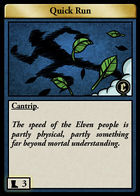
|
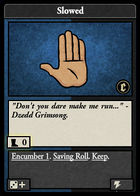
|
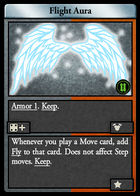
|
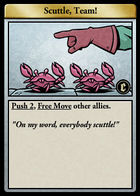
|
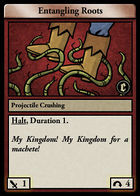
|
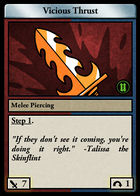
|
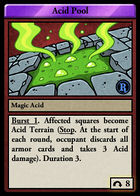
|
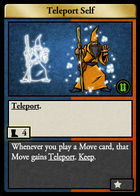
|
Cantrip: Movement cards that contain the Cantrip keyword allow the player to get a new turn after activation. Quick Run and Quick Step are two examples. Quick Run allows the player to move a character three squares and get an extra turn. Cantrip cards combo well with attacks as it allows a character to move behind an enemy and deal damage without fear of being blocked.
Encumber: Encumber is a common effect that restricts the movement range of move cards. An example is Slowed. When Slowed is in your hand, any move card played has a chance of its movement range reduced by 1. Playing a Shuffle with Slowed in hand has a chance of reducing the total movement range to 0. Multiple encumber deductions are possible and serve to restrict an enemy's movement.
Fly: A card with the Fly keyword enhances any move cards played by providing the ability to move through impassable terrain and ignore stops. This is useful in negotiating narrow restrictive maps littered with obstacles. Flight Aura is an example of a reaction based move enhancer. If you play a Walk with Flight Aura in hand, it allows the character to fly over terrains to a target spot and cross difficult terrains without stopping.
Free Move: Free move is a powerful ability that disregards terrain costs and all stops, including an enemy's zone of control. The difference between Fly and Free Move is that Fly allows the move to fly over impassable and difficult terrains. Free Move does not. Therefore, it is possible to fly into a terrain completely enclosed by impassable terrains but it is not possible to free move into one.
Halt: Widely considered as one of the most potent move restriction mechanic, Halt completely negates the use of move cards, including hybrid cards that consist a move component (blue card background). This usually shuts down melee opponents, rendering them sitting ducks. Entangling Roots is a commonly available attack that carries the halt keyword. Simply cast it on unsuspecting warriors for funny results.
Push: Push is an keyword that moves a target character for a distance of up to X where X is the number after the word Push. This mechanic is executed as a regular terrain move, all terrain restrictions and zones of control apply. Scuttle, Team! is an example of a card that contains the Push ability. It provides the caster the the option to Push its allies up to two squares in any direction. By doing so, the allies do not have to use their in-hand move cards. Team based moves are useful for strategic positioning. In addition, Scuttle, Team! also contains the Free Move keyword. This means that allies can be moved over terrain disregarding terrain costs and all stops, including an enemy's zone of control.
Step: One of the warrior's favorite hybrid class attack mechanic, Step gives the ability to move a character prior to any other instructions on the card. An all-time warrior's favorite card, Vicious Thrust allows the player to move a character from two squares away into close proximity of an enemy and deliver a penetrating attack. Regular terrain restrictions apply. Due to its burst-like nature, warriors that specialize in step attacks are widely considered dangerous and feature commonly in high ranked pvp parties. Encumber, Halt and Stop are common counters to Step.
Stop: Some terrain attachments in Card Hunter transform the underlying terrain into difficult terrain via the Stop keyword. By doing so, a character is forced to end its moves when entering such tiles. Examples include Acid Pool, Rockfall, Wall of Illusion etc. Terrain based cards are highly useful in slowing enemy advance while dealing damage or keeping melee enemies away from fragile ranged units.
Teleport: Teleport describes a type of movement accomplished by arcane means. All obstacles are ignored during teleportation, including blocked terrain and stops. The difference between Teleport and Fly is that Teleport allows movement thru blocked terrain while Fly does not. The destination must not be an impassable terrain or an already occupied tile. Therefore, it is possible to Teleport into a terrain completely enclosed by blocked terrains but it is not possible to Fly into one. Table 1 below shows the summarized differences between Fly, Free Move and Teleport.
| Difficult terrain | Blocked terrain | Impassable terrain | |
|---|---|---|---|
| Free Move | Ignores stop | Cannot free move thru | Cannot free move over |
| Fly | Ignores stop | Cannot fly thru | Can fly over |
| Teleport | Ignores stop | Can teleport thru | Can teleport over |
